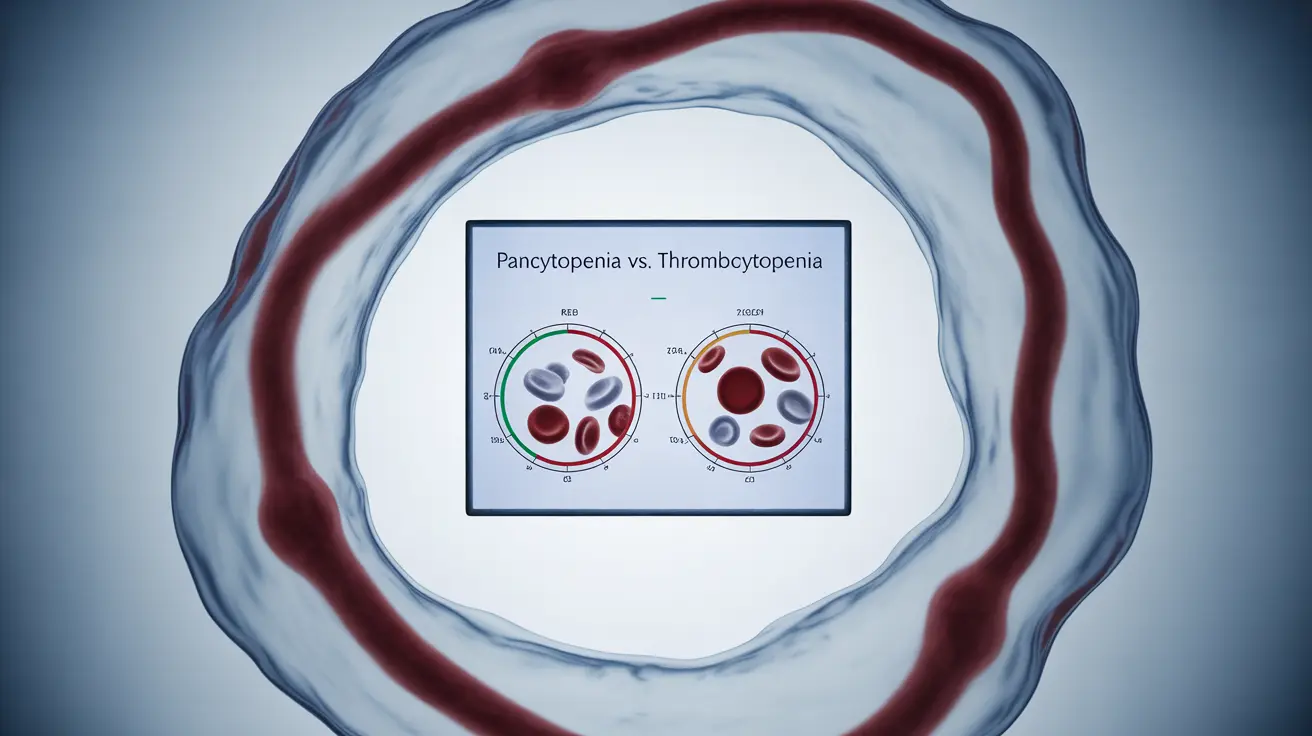Blood disorders can significantly impact overall health, and understanding the distinctions between different conditions is crucial for proper diagnosis and treatment. Two commonly confused blood disorders are pancytopenia and thrombocytopenia. While they share some similarities, these conditions affect blood cells differently and require distinct therapeutic approaches.
This comprehensive guide explores the key differences between pancytopenia and thrombocytopenia, helping you understand their unique characteristics, diagnostic processes, and treatment options.
Defining the Conditions
Thrombocytopenia is a specific condition characterized by low platelet counts in the blood. Platelets are crucial for blood clotting, and their deficiency can lead to increased bleeding risk. In contrast, pancytopenia is a more comprehensive condition affecting all three main types of blood cells: red blood cells, white blood cells, and platelets.
Understanding the Impact on Blood Cells
Thrombocytopenia's Specific Effects
In thrombocytopenia, only platelet counts fall below normal levels (typically less than 150,000 platelets per microliter). This isolated decrease primarily affects blood clotting ability, leaving other blood cell functions intact.
Pancytopenia's Broader Impact
Pancytopenia involves the simultaneous reduction of all three major blood cell types:
- Red blood cells (causing anemia)
- White blood cells (leading to increased infection risk)
- Platelets (resulting in bleeding tendency)
Causes and Risk Factors
Thrombocytopenia Causes
Common causes of isolated thrombocytopenia include:
- Immune system disorders
- Certain medications
- Viral infections
- Pregnancy
- Bone marrow disorders
Pancytopenia Causes
Pancytopenia typically results from more systemic conditions:
- Bone marrow failure
- Leukemia
- Severe nutritional deficiencies
- Chemotherapy
- Advanced autoimmune diseases
Clinical Manifestations
Thrombocytopenia Symptoms
Primary symptoms include:
- Easy bruising
- Petechiae (small red spots)
- Prolonged bleeding from cuts
- Nose bleeds
- Bleeding gums
Pancytopenia Symptoms
Symptoms are more extensive and may include:
- Fatigue and weakness
- Frequent infections
- Easy bruising and bleeding
- Shortness of breath
- Pale skin
- Fever
Diagnostic Approaches
Proper diagnosis requires different testing strategies:
- Complete blood count (CBC)
- Bone marrow examination (when necessary)
- Additional specialized blood tests
- Imaging studies in some cases
Treatment Strategies
Treatment approaches vary significantly between the conditions:
- Thrombocytopenia often focuses on addressing the underlying cause and may include corticosteroids or immunoglobulins
- Pancytopenia requires more comprehensive treatment, potentially including blood transfusions, growth factors, or bone marrow transplantation in severe cases
Frequently Asked Questions
What are the main differences between pancytopenia and thrombocytopenia in terms of causes and symptoms?
Pancytopenia affects all three blood cell types and typically results from systemic conditions, while thrombocytopenia only affects platelets and can have more isolated causes. Symptoms of pancytopenia are more extensive, including fatigue, infections, and bleeding, while thrombocytopenia primarily causes bleeding-related symptoms.How do doctors diagnose pancytopenia versus isolated thrombocytopenia?
Both conditions require blood tests, but pancytopenia diagnosis involves more comprehensive evaluation of all blood cell lines. Bone marrow examination is more commonly needed in pancytopenia cases to determine the underlying cause.What treatment options are available for pancytopenia compared to thrombocytopenia?
Thrombocytopenia treatment typically focuses on addressing specific platelet issues, while pancytopenia requires broader therapeutic approaches, potentially including multiple blood product transfusions and bone marrow stimulation.Can thrombocytopenia lead to pancytopenia or are they completely separate conditions?
While they're typically separate conditions, some underlying causes of thrombocytopenia can progress to affect other blood cell lines, potentially leading to pancytopenia. However, this progression isn't common with isolated thrombocytopenia.What symptoms should prompt someone to seek medical advice for possible pancytopenia or thrombocytopenia?
Seek immediate medical attention for unexplained bruising, prolonged bleeding, frequent infections, severe fatigue, or shortness of breath. These symptoms could indicate either condition and require proper medical evaluation.




